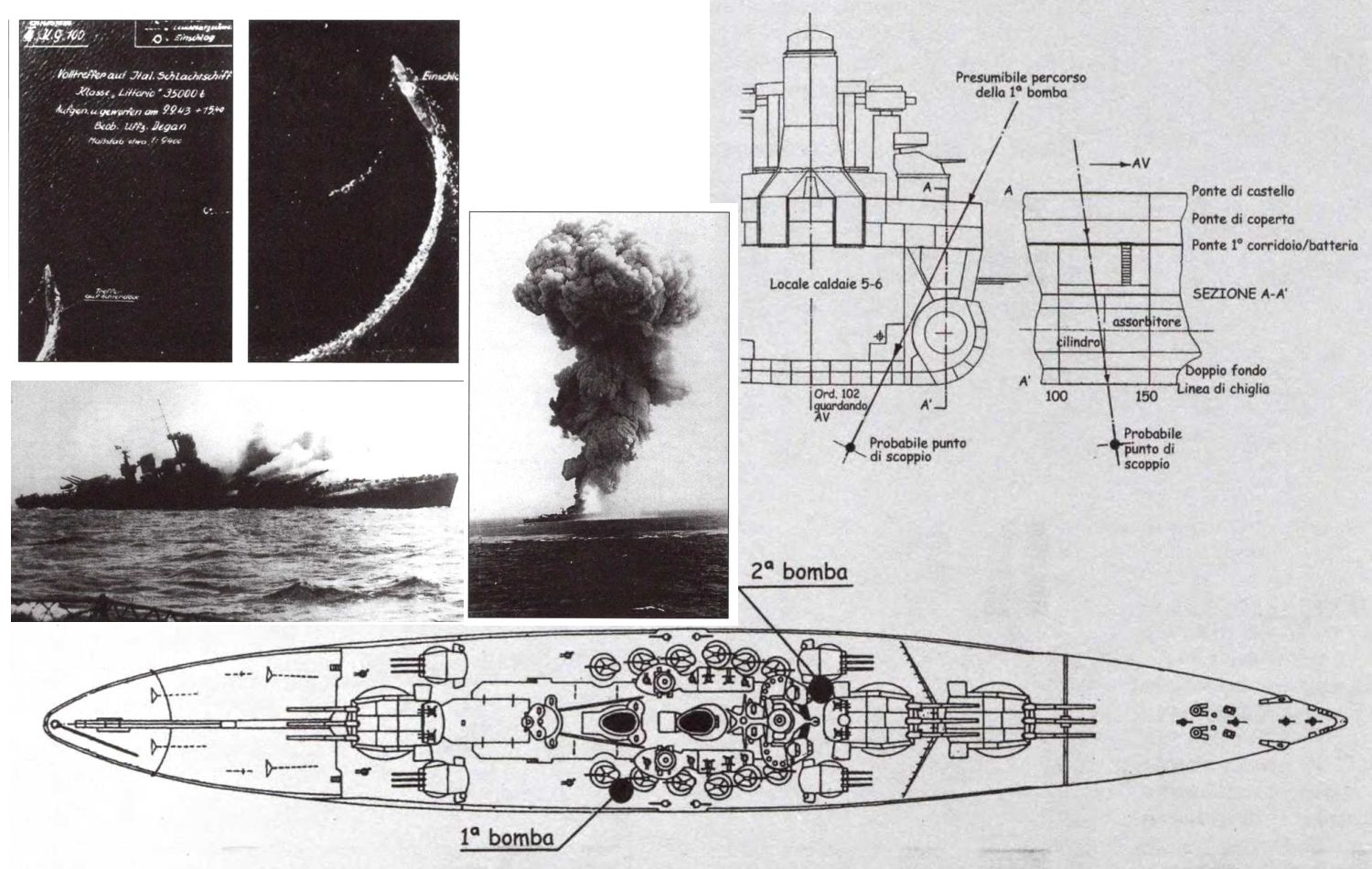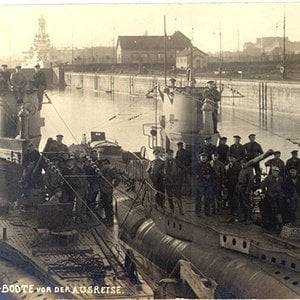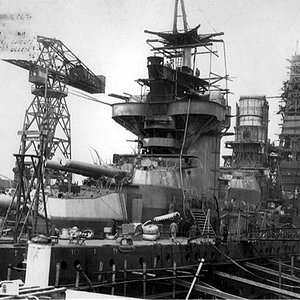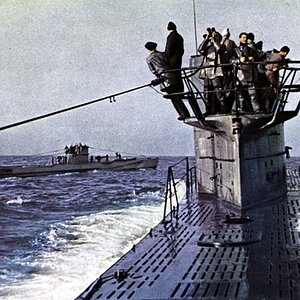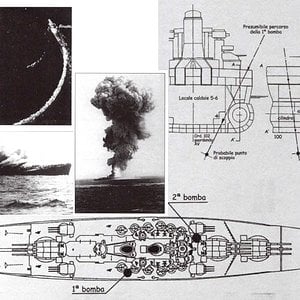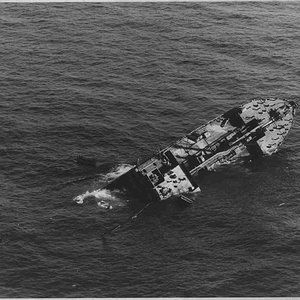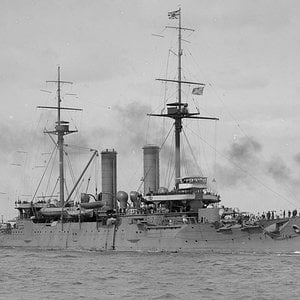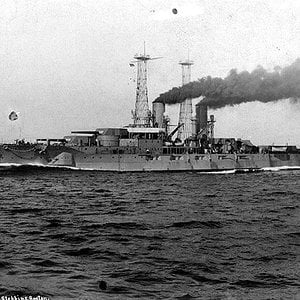Navigation
Install the app
How to install the app on iOS
Follow along with the video below to see how to install our site as a web app on your home screen.
Note: This feature may not be available in some browsers.
More options
You are using an out of date browser. It may not display this or other websites correctly.
You should upgrade or use an alternative browser.
You should upgrade or use an alternative browser.
Although the German aircraft were from a unit specially formed to use the FRITZ-X bomb, the first damage was caused by a normal type bomb; the battleship ITALIA suffered a near miss toward the stern, putting the main steering temporarily out of action, although she managed to continue to steer on her engines and auxiliary steering.
About 5 minutes later a FRITZ-X bomb struck the ROMA amidships on the starboard side; the high velocity of the bomb, due to its trajectory and rocket propulsion, caused it to pass right through the ship and detonate beneath the hull. The ROMA’S two sternmost propellers were put out of action, and speed dropped immediately from 25 to 16 knots. About 5 minutes later the ROMA was struck another grave blow; a FRITZ-X bomb struck her in almost the same place as the previous bomb, penetrating to the engine room where it exploded, setting off an explosion in the forward magazine where the ammunition for the 381mm guns was stored.
The explosion was of vast proportions; the entire control tower was destroyed and the ship rapidly became a raging furnace, with flames towering to great height. The ship rapidly took on a list of 12 degrees to starboard, when the listing motion was briefly halted, then continued to worsen until she capsized completely. Almost immediately the hull broke into two sections, the stern section sinking rapidly, and the bow section much more slowly. Of the ROMA’s 1,849 crew only 596 survived, many of them suffering from terrible burns.
At almost the same time as the ROMA was hit, the ITALIA was also hit by a FRITZ-X bomb, fortunately with much less serious results; the bomb went through the ship transversely, penetrating two decks and exiting on the other side where it exploded in the sea, blowing a large hole in the side through which thousands of tons of water poured into the ship. The battleship, however, although slightly down by the head, managed to continue at maximum speed.
After detaching the light cruiser ATTILIO REGOLO, 3 destroyers, and 4 torpedo boats, to pick up survivors (these vessels later put in to Port Mahon in the Balearic Islands, where they were interned), the squadron, whose command had been taken over by Admiral Romeo Oliva, aboard the EUGENIO DI SAVOIA (the flagship of the 7th Division), headed south where it met up with the Anglo/American naval force sent to escort it to Malta.
Admiral Bergamini was posthumously awarded two Gold Medals;
About 5 minutes later a FRITZ-X bomb struck the ROMA amidships on the starboard side; the high velocity of the bomb, due to its trajectory and rocket propulsion, caused it to pass right through the ship and detonate beneath the hull. The ROMA’S two sternmost propellers were put out of action, and speed dropped immediately from 25 to 16 knots. About 5 minutes later the ROMA was struck another grave blow; a FRITZ-X bomb struck her in almost the same place as the previous bomb, penetrating to the engine room where it exploded, setting off an explosion in the forward magazine where the ammunition for the 381mm guns was stored.
The explosion was of vast proportions; the entire control tower was destroyed and the ship rapidly became a raging furnace, with flames towering to great height. The ship rapidly took on a list of 12 degrees to starboard, when the listing motion was briefly halted, then continued to worsen until she capsized completely. Almost immediately the hull broke into two sections, the stern section sinking rapidly, and the bow section much more slowly. Of the ROMA’s 1,849 crew only 596 survived, many of them suffering from terrible burns.
At almost the same time as the ROMA was hit, the ITALIA was also hit by a FRITZ-X bomb, fortunately with much less serious results; the bomb went through the ship transversely, penetrating two decks and exiting on the other side where it exploded in the sea, blowing a large hole in the side through which thousands of tons of water poured into the ship. The battleship, however, although slightly down by the head, managed to continue at maximum speed.
After detaching the light cruiser ATTILIO REGOLO, 3 destroyers, and 4 torpedo boats, to pick up survivors (these vessels later put in to Port Mahon in the Balearic Islands, where they were interned), the squadron, whose command had been taken over by Admiral Romeo Oliva, aboard the EUGENIO DI SAVOIA (the flagship of the 7th Division), headed south where it met up with the Anglo/American naval force sent to escort it to Malta.
Admiral Bergamini was posthumously awarded two Gold Medals;

